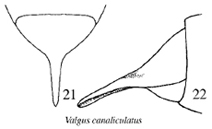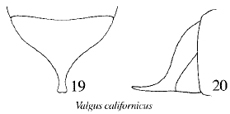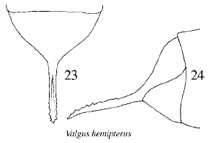| 1. . . |
Terminal spiracles conical, distinctly produced (Fig. 12). Posterior tarsomeres subequal in length |
. |
| 1'.
. . . |
Terminal spiracles not distinctly produced. Posterior tarsus with first tarsomere as long as or longer than tarsomeres 2 and 3 combined |
|
 Figure 12. Lateral view of abdomen of Dasyvalgus mexicanus showing conical terminal spiracle. |
||
| 2(1). . . . |
Lateral edges of pronotum not serrate (Fig. 13; setae may need to be removed to view edge of pronotum). Female with short, scoop-like pygidial spine (Fig. 19); spine moderately recurved in lateral view (Fig. 20) |
|
| 2'.
. . . . . |
Lateral edges of pronotum serrate (Fig. 14; setae may need to be removed to view edge of pronotum). Female without pygidial spine (Fig. 25) or, if present, female with acuminate pygidial spine (Figs. 21, 23); spine moderately decurved in lateral view (Figs. 22, 24) |
|
 |
 |
Figures 13-14. Lateral view of head and pronotum in Valgus californicus and Valgus canaliculatus (respectively) showing nonserrate (13) or serrate (14) pronotal margin. |
|
| . | |
 |
 |
 |
 |
Figures 19-26. Dorsal and lateral views (respectively) of female pygidium and pygidial spines in: 19-20) Valgus californicus, 21-22) Valgus canaliculatus, 23-24) Valgus hemipterus, and 25-26) Valgus seticollis. |
|
| 3(2). . . . . . |
Body length (as measured from apex of pronotum to apex of pygidium) 4.0-6.0 mm. Female without pygidial spine (Figs. 25-26) or pygidial spine of female without lateral serrations (Figs. 21-22). Elytral cuticular color reddish-brown, brown, or castaneous |
|||||||||||
| 3'. . . . |
Body length (as measured from apex of pronotum to apex of pygidium) 8.0-9.0 mm. Pygidial spine of female with irregular, lateral serrations (Figs. 23-24). Elytral cuticular color piceous |
. Valgus hemipterus (L.) |
||||||||||
|
||||||||||||
| 4(3). . . . . |
Male with dense patch of overlapping yellow and cream-colored setae on ventral surface of abdomen. Female with acuminate pygidial spine (Fig. 21); spine decurved in lateral view (Fig. 22). Elytral cuticular color reddish-brown or brown |
. |
| 4'.
. . . . . |
Male with moderately dense, tawny setae on ventral surface of abdomen, setae not overlapping and dense. Female without acuminate pygidial spine (Figs. 25-26). Elytral cuticular color of male reddish-brown; cuticular color of female castaneous |
. |
 |
 |
Figures 21-22, 25-26. Dorsal and lateral views (respectively) of female pygidium and pygidial spines in: 21-22) Valgus canaliculatus, and 25-26) Valgus seticollis. |
|